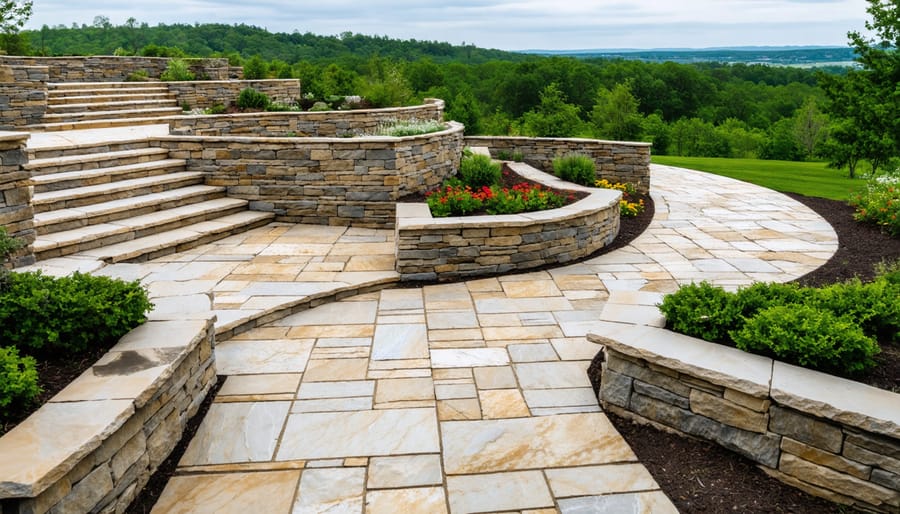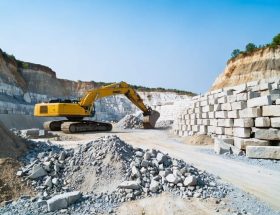Stone fences stand as testament to both architectural ingenuity and timeless craftsmanship, transforming ordinary boundaries into striking landscape features. From the rugged beauty of traditional dry-stack walls to the precise engineering of mortared natural stone walls, these enduring structures merge form with function across diverse architectural styles and environments.
Modern stone fence construction encompasses five distinct categories: dry-stack, mortared, gabion, boulder, and hybrid designs. Each type offers unique advantages in durability, aesthetics, and installation requirements, allowing property owners to select the perfect balance between visual impact and practical performance. While traditional methods date back centuries, contemporary engineering and material innovations have enhanced these time-tested techniques, creating fencing solutions that withstand both time and elements while complementing modern architectural demands.
Whether defining property boundaries, creating privacy screens, or serving as retaining walls, stone fences deliver unmatched versatility and permanence. Understanding the distinct characteristics, construction requirements, and maintenance needs of each type ensures optimal selection for specific site conditions and design objectives.
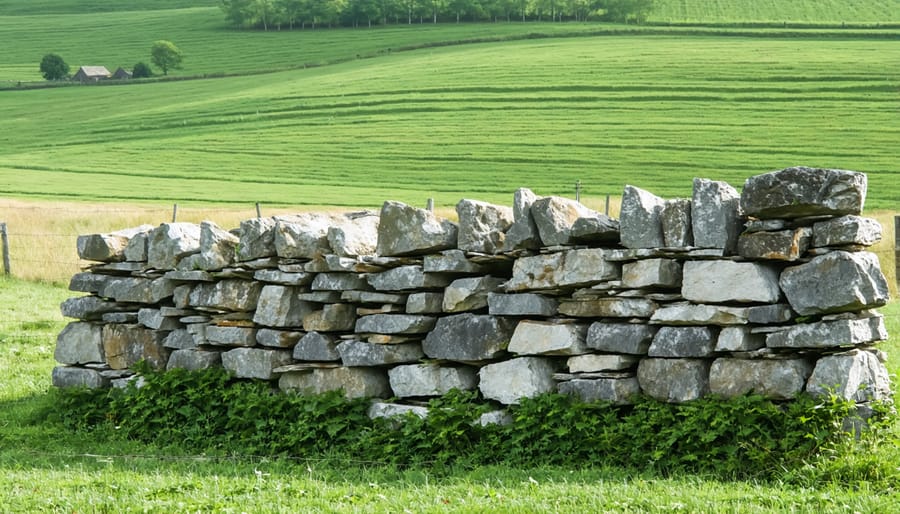
Dry Stack Stone Fences
Building Techniques
Dry stack stone fence construction begins with establishing a solid foundation trench, typically 8-12 inches deep and twice the wall’s width. The trench should be filled with gravel and compacted to create a stable base. Larger stones are placed at the bottom, creating a sturdy foundation layer.
As construction progresses, stones are carefully selected and fitted together like a puzzle, with each piece nestled securely against its neighbors. The key to stability is ensuring each stone contacts at least three others, creating a natural interlocking system. Smaller stones, called hearting, fill internal gaps to enhance structural integrity.
The wall should be built with a slight taper, approximately 1 inch inward for every foot of height. This “batter” provides additional stability. Through stones, which span the width of the wall, are placed every few feet to tie the structure together. The top course typically features larger cap stones, carefully positioned to protect the wall from water damage.
Professional masons often use string lines and levels to maintain straight lines and proper angles, though traditional walls may follow natural contours of the landscape.
Stone Selection
The foundation of a successful dry stack fence lies in proper stone selection. Granite and limestone are popular choices due to their durability and natural weathering resistance. These stones maintain their structural integrity over time while developing an attractive patina. Fieldstone, commonly found in rural areas, offers an authentic rustic appearance and typically features flat surfaces that stack well.
For optimal stability, choose stones with at least two relatively flat sides and varying sizes. Larger stones (8-12 inches in diameter) form the foundation and cornerstones, while smaller pieces (4-6 inches) fill gaps and create visual interest. Angular stones interlock better than rounded ones, providing enhanced structural stability without mortar.
Local quarry stone often proves ideal, as it’s adapted to regional climate conditions and matches the area’s natural aesthetic. Slate and sandstone can work well in certain regions but require careful consideration due to their tendency to weather more quickly. Regardless of type, stones should be dense, weather-resistant, and free from cracks or signs of deterioration.
Mortared Stone Fences
Construction Methods
Mortared stone fences are constructed by carefully layering stones with a strong mortar mixture that bonds them together permanently. The process begins with excavating and pouring a proper concrete foundation that extends below the frost line to prevent shifting and cracking. Builders then create forms on both sides of the fence line to maintain consistent width and alignment.
The construction involves selecting stones of varying sizes, with larger stones placed at the base for stability. Each stone is carefully positioned and leveled, with mortar applied between layers. Special attention is paid to creating strong corners and end posts, which provide structural integrity to the entire fence. Builders typically work in sections of 3-4 feet at a time to ensure proper mortar setting.
A mixture of Portland cement, sand, and water creates the mortar that bonds the stones. The joints between stones are typically raked and finished while the mortar is still workable, creating either a flush or recessed appearance. Proper curing time is essential, usually requiring several days of controlled moisture conditions to achieve maximum strength. Expansion joints are incorporated every 20-30 feet to accommodate natural movement and prevent cracking.
Design Variations
Mortared stone fences offer endless possibilities for creative design variations that can enhance any property’s aesthetic appeal. The most common pattern is the random rubble style, where stones of various sizes are fitted together like a puzzle, creating an organic, natural appearance. For a more formal look, ashlar patterns feature uniformly cut stones arranged in regular courses, lending elegance and sophistication to the design.
Mosaic patterns incorporate smaller stones in decorative arrangements, often including contrasting colors or materials for visual interest. Horizontal coursing creates strong linear elements, while vertical stacking produces a dramatic contemporary effect. Some designs incorporate built-in features like pillars, curved sections, or decorative caps to add architectural interest.
Mixing stone types or combining different laying patterns can create unique visual effects. For example, large flat stones might frame smaller, rounded river rocks, or granite blocks might alternate with limestone courses. These design variations can be further enhanced through different mortar colors and joint treatments, from deeply recessed joints to flush pointing, each creating distinct shadow lines and textures.
Gabion Stone Fences
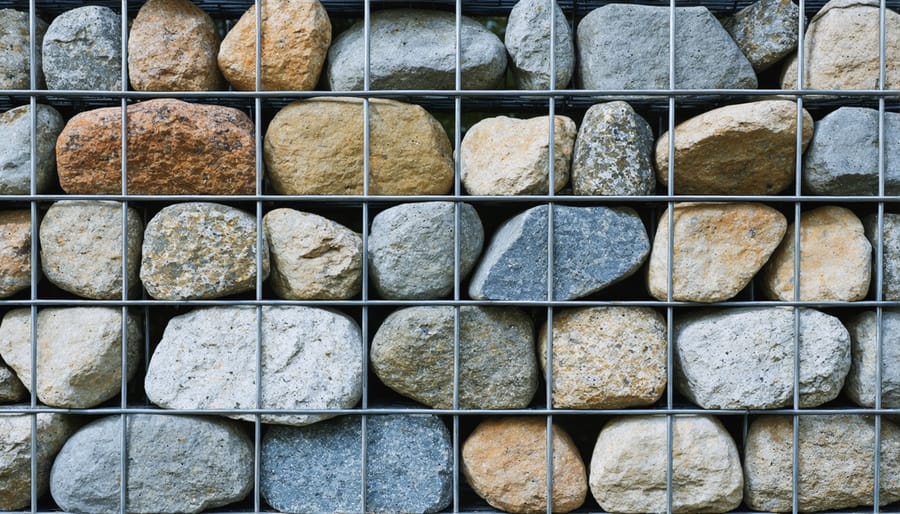
Modern Applications
Gabion fences have gained significant popularity in contemporary landscape design, offering a perfect blend of industrial aesthetics and natural elements. These versatile structures consist of wire mesh containers filled with stones, creating robust barriers that serve both functional and decorative purposes. Modern architects frequently incorporate gabion fencing into sustainable building projects, particularly for retaining walls, privacy screens, and garden boundaries.
Today’s gabion applications extend beyond traditional stone containment, with designers experimenting with mixed materials like recycled glass, wood, and even LED lighting between stone layers. In urban settings, these fences serve as sound barriers along highways while providing an attractive alternative to concrete walls. Residential applications often feature gabion fences as statement pieces, with carefully selected stone colors and sizes creating stunning visual patterns.
The adaptability of gabion fencing allows for creative installations, including curved designs, varying heights, and integration with vegetation, making them increasingly popular in modern sustainable architecture and landscape design.
Installation Process
Installing a gabion stone fence begins with careful site preparation and foundation work. First, excavate a level trench that’s approximately 6 inches deeper than the planned fence height. Pour a concrete foundation that’s reinforced with rebar to ensure stability. Once cured, position the gabion baskets according to your design layout.
Assemble the wire mesh baskets on-site, securing all connections with spiral wire ties. Install temporary bracing boards inside the baskets to prevent bulging during stone filling. Layer the stones carefully, placing larger pieces along the visible faces and filling internal spaces with smaller stones. Similar to stone veneer installation techniques, attention to detail in stone placement ensures an attractive finished appearance.
Continue filling each basket section, maintaining even distribution of stone sizes. Once filled, secure the top lid and remove temporary bracing. For additional stability, connect adjacent baskets using wire ties at regular intervals. The installation process typically requires 2-3 days for a standard 20-foot section.
Stone Veneer Fences
Materials and Options
Stone veneers come in a diverse range of options to suit various architectural styles and budgetary requirements. Natural stone veneers include limestone, granite, slate, and sandstone, each offering unique textures and color variations. These materials can be cut to different thicknesses and shapes, allowing for customized appearances. Manufactured stone veneers provide a cost-effective alternative while closely mimicking natural stone aesthetics.
Thin stone veneers, typically 1-inch thick, are increasingly popular for their lighter weight and easier installation process. Full-bed veneers, measuring 3-5 inches thick, offer a more substantial appearance and traditional look. Color options range from earth tones like browns and tans to dramatic grays and blues, with finishes varying from rough-split to smooth-honed surfaces. When selecting materials, consider factors like climate exposure and maintaining stone surfaces in your specific environment.
Application Methods
Stone veneer fences can be installed using two primary methods: dry-stack and mortared construction. The dry-stack technique involves carefully placing stones without mortar, relying on gravity and precise fitting for stability. This method requires skilled craftsmanship and careful stone selection to ensure proper interlocking.
Mortared construction, the more common approach, uses mortar to bond stones together. This begins with a solid concrete foundation and steel reinforcement. Stones are laid in courses, with mortar joints typically ranging from 3/8 to 1/2 inch. Each stone is placed with its best face showing and supported by smaller stones or shims as needed.
For both methods, proper drainage is essential. Installation should include weep holes at the base and drainage material behind the fence. Weather conditions during construction are crucial – mortar shouldn’t be applied in freezing temperatures or extreme heat. Professional installation is recommended due to the structural requirements and expertise needed for proper stone placement and alignment.
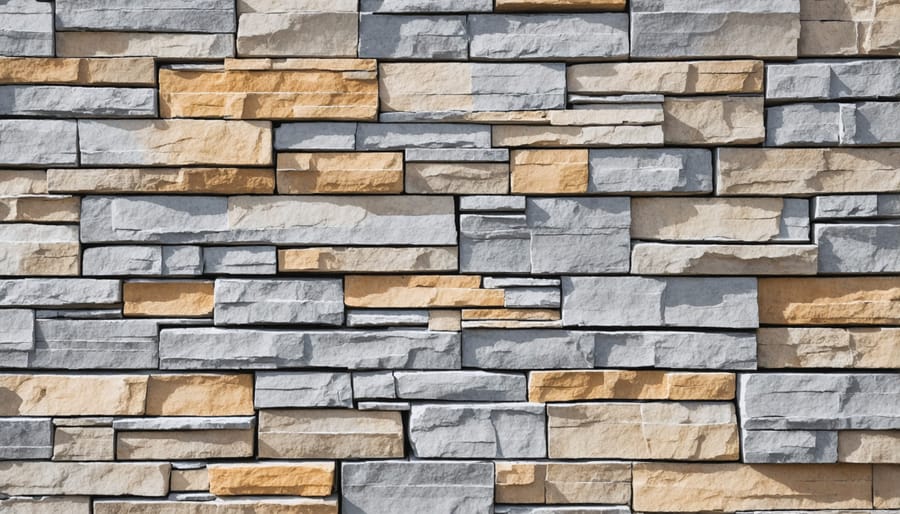
Maintenance and Care
Regular Maintenance
Regular maintenance is essential to preserve the structural integrity and aesthetic appeal of stone fences. Inspect your fence twice yearly, ideally in spring and fall, checking for loose stones, deteriorating mortar, or signs of shifting. Clear any vegetation growing between stones, as roots can cause structural damage over time.
For mortared stone fences, examine the joints carefully and repair any cracked or missing mortar promptly to prevent water infiltration. Use a wire brush to clean off moss, algae, or other organic growth that could trap moisture and accelerate deterioration. Dry-stack stone fences require periodic realignment of stones that may have shifted due to ground movement or weather conditions.
After heavy storms or freeze-thaw cycles, conduct additional inspections to address any immediate concerns. Clean the fence surface annually using a gentle pressure washer or garden hose to remove dirt and debris. Avoid harsh chemical cleaners that might damage the stone’s natural patina. For historic stone fences, consult a preservation specialist for appropriate maintenance techniques that maintain the fence’s authentic character while ensuring its longevity.
Common Issues and Solutions
Despite their durability, stone fences can develop various issues over time. Foundation settling is a common problem that can cause stones to shift or walls to lean. This typically requires professional assessment and may involve rebuilding affected sections to ensure structural integrity.
Moisture-related problems, including efflorescence (white mineral deposits) and moss growth, frequently affect stone fences. Regular cleaning with appropriate stone cleaners and ensuring proper drainage can prevent these issues. Water damage can be particularly severe in freeze-thaw climates, where expanding ice can crack or displace stones.
Mortar deterioration in mortared stone fences often occurs after 20-30 years. Signs include crumbling mortar joints and loose stones. Repointing, which involves removing and replacing damaged mortar, is the standard solution. For dry-stack walls, stone displacement is common, especially after heavy rains or ground movement. Regular inspection and promptly resetting displaced stones prevents more extensive damage.
Vegetation growth between stones can destabilize the structure. While some plants add aesthetic appeal, invasive roots must be removed to maintain wall integrity. Using landscape fabric behind the fence can help minimize this issue.
Selecting the right stone fence type requires careful consideration of multiple factors that we’ve explored throughout this guide. Each style – from traditional dry-stack to modern mortared walls – offers unique benefits and aesthetic appeal. The key is matching your specific needs with the appropriate fence type.
For durability and minimal maintenance, mortared stone fences prove ideal for most residential applications. However, if you’re seeking a more rustic, traditional appearance and have access to skilled craftsmen, dry-stack walls offer timeless charm and natural drainage. Gabion fences present an excellent solution for modern landscapes and challenging terrain, while boulder walls make striking statements in larger properties.
Consider your climate, local stone availability, and maintenance capabilities when making your selection. Budget also plays a crucial role, as installation costs vary significantly between different fence types. Remember that proper construction is essential regardless of style – professional installation ensures longevity and structural integrity.
The right stone fence can enhance your property’s value, provide security, and create lasting visual impact. Whether you choose the precision of cut stone, the natural beauty of fieldstone, or the industrial appeal of gabion construction, ensure your selection aligns with your property’s architecture and your long-term maintenance expectations. When properly planned and executed, a stone fence becomes more than just a boundary – it’s an enduring investment in your property’s character and functionality.

